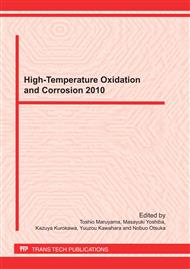p.156
p.162
p.170
p.176
p.183
p.189
p.194
p.200
p.206
Suppression of Surface Hot Shortness Caused by Copper during Hot Rolling
Abstract:
Since copper content in steel causes hot shortness, it is important to understand copper behaviour during high-temperature oxidation, in order to control the precipitated copper. This study examines copper distribution during the oxidation of steel. From the oxidation tests, it is shown that precipitated copper existing in the scale/steel interface is absorbed into the magnetite layer or evaporates into the atmosphere. Then, a proposed method to suppress hot shortness is tested by oxidation-tensile tests at high temperature and is proven to be effective.
Info:
Periodical:
Pages:
183-188
Citation:
Online since:
September 2011
Authors:
Keywords:
Price:
Сopyright:
© 2011 Trans Tech Publications Ltd. All Rights Reserved
Share:
Citation:


